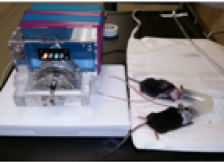The spearheaded by us heterochronic parabiosis studies have established the fundamental paradigm that the age-related decline of progenitor cell activity can be modulated by systemic factors that change with age.


In contrast to skin suturing of parabiosis, in our more recent small animal blood exchange system animals are connected and disconnected at will, in order to uncouple the properties of the endocrine–systemic milieu from those changes which are caused by the sharing of organ systems and/or adaptations to being surgically joined for several weeks.
The results from heterochronic blood exchange suggest that the identification and removal of circulating inhibitors of old blood is important as being therapeutic itself and for enhancing effects of ectopic “young” factors. Blood exchange in small animals enables well-controlled studies with rapid translation for therapy for humans, and we are working on repositioning FDA approved apheresis for preventing, attenuating and reversing age-imposed degenerative, metabolic and inflammatory diseases through novel design of cell and molecule filtration modules.

Dr. Justin Rebo (Conboy lab → CMO at ImmunePath)

Dr. Kiana Aran (Conboy lab
→ Associate Professor KGI)
- Conboy IM, Conboy MJ, Wagers AJ, Girma ER, Weissman IL, Rando TA. Rejuvenation of aged progenitor cells by exposure to a young systemic environment.Nature. 2005 Feb 17;433(7027):760-4.PMID:15716955
- Rebo J, Mehdipour M, Gathwala R, Causey K, Liu Y, Conboy MJ, Conboy IM.A single heterochronic blood exchange reveals rapid inhibition of multiple tissues by old blood. Nat Commun. 2016 22;7. PMID: 27874859.
- This body of work is reviewed in Aging Cell. 2013 Jun;12(3):525-30. PMID:23489470